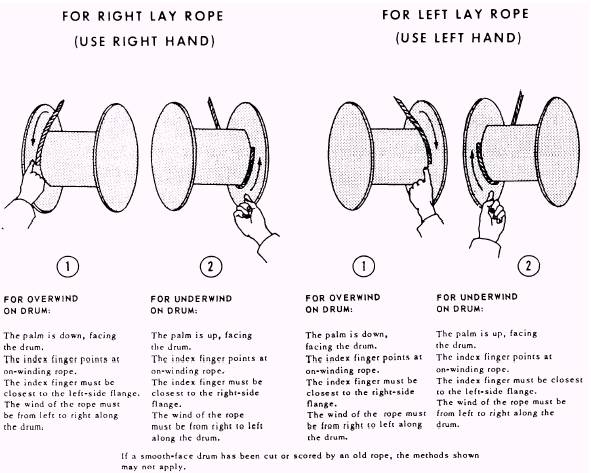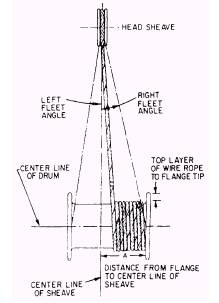|
Kinks One of the most common forms of damage resulting from improper handled wire rope is the development of a kink. A kink starts with the formation of a loop, as shown in figures 13-10 and 13-11. A loop that has not been pulled tight enough to set the wires or strands of the rope into a kink can be removed by turning the rope at either end in the proper direction to restore the lay, as shown in figure 13-12. If this is not done and the loop is pulled tight enough to cause a kink (fig. 13-13), the kink will result in irreparable damage to the rope (fig. 13-14).

Figure 13-12.-The correct way to take out a loop in a wire rope.

Figure 13-13.-Wire rope kink.

Figure 13-14.-Kink damage.

Figure 13-10.-Improper handling.

Figure 13-11.-Wire rope loop. Kinking can be prevented by proper uncoiling and unreeling methods and by the correct handling of the rope throughout its installation. Drum Winding Spooling wire rope on a crane hoist drum causes a slight rotating tendency of the rope due to the spiral lay of the strands. Two types of hoist drums used for spooling wire rope are as follows: 1. Grooved drum. When grooved drums are used, the grooves generally give sufficient control to wind the wire rope properly, whether it is right or left lay rope. 2, Smooth-faced drum. When smooth-faced drums are used, where the only other influence on the wire rope in winding on the first layer is the fleet angle, the slight rotational tendency of the rope can be used as an advantage in keeping the winding tight and uniform. NOTE: Using the wrong type of wire rope lay causes the rotational tendency of the rope to be a disadvantage, because it results in loose and nonuniform winding of the rope on the hoist drum. Figure 13-15 shows drum winding diagrams for selection of the proper lay of rope. Standing behind the hoist drum and looking toward an oncoming overwind rope, the rotating tendency of right lay rope is toward the left; whereas, the rotating tendency of a left lay rope is toward the right. Refer to figure 13-15. With overwind reeving and a right lay rope on a smooth-faced drum, the wire rope bitter end attachment to the drum flange should be at the left flange. With underwind reeving and a right lay rope, the wire rope bitter end attachment should beat the right flange. When wire rope is run off one reel onto another or onto a winch or drum, it should be run from TOP TO

Figure 13-15.-Different lays of wire rope winding on hoist drums.

Figure 13-16.-Transferring wire rope from reel to drum.

Figure 13-17.-Fleet angle relationship. TOP or from BOTTOM TO BOTTOM, as shown in figure 13-16. Fleet Angle The fleet angle is formed by running wire rope between a sheave and a hoist drum whose axles are parallel to each other, as shown in figure 13-17. Too large a fleet angle can cause the wire rope to climb the flange of the sheave and can also cause the wire rope to climb over itself on the hoist drum.
|

